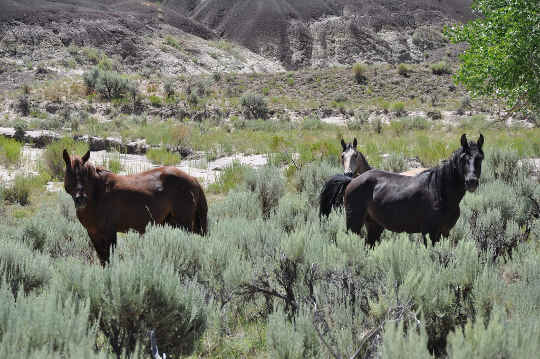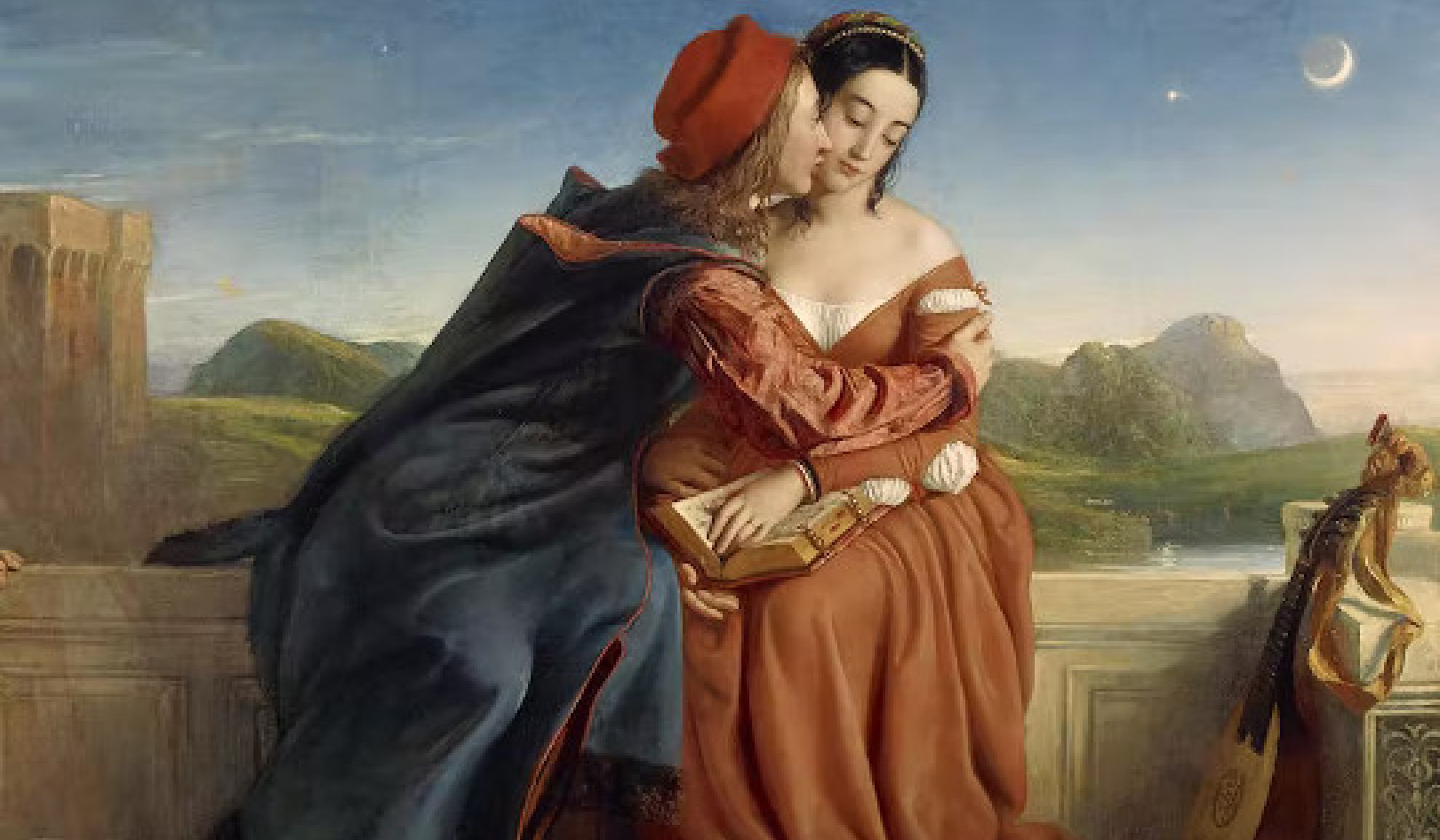
Photo credits: Kevin Kunkel, New Mexico Intern, Bureau of Land Management. (cc 2.0)
Several years ago, I adopted three young mares from a local horse rescue. Leyla, a brown-and-white paint with striking blue eyes, walked right up to me the day we met, while Brandi, a chestnut with a flaxen mane and tail, watched from a safe distance. Feisty little Savannah — a delicate, spirited buckskin — also kept her distance, though her gaze seemed more suspicious than shy.
When bringing new horses onto the property, I always keep them separate for a couple of weeks to make sure they aren’t carrying any communicable diseases. But since Leyla, Brandi, and Savannah had already been living together with a large group of mares at the Equine Voices rescue center, I turned them out together in a half-acre corral away from the rest of my herd.
Differences Between Leader, Dominant, and Nurturer/Companion
Within a matter of weeks, I couldn’t believe my good fortune. In observing the already well-established dynamics of this trio, I realized that I had somehow managed to acquire a mini-herd whose members exemplified the differences between the Leader, the Dominant, and the Nurturer/Companion, with all three trading the Sentinel role as needed.
These mares were so closely bonded, so in sync with one another, that my staff and I began calling them the “Spice Girls.” Like the British band, each member was beautiful in her own unique way. The group also proved to be unusually resistant to letting other horses into their “girl-power” clique.
By far the smallest of the three, Savannah was the alpha. At dinnertime, the caramel-colored beauty would not only strut toward the feeder of her choice, she would chase Brandi and Leyla away from their hay at various points during the meal. Sometimes Savannah would let them eat with her, but it was clearly a privilege that could be revoked on a whim. True to her dominant personality, the buckskin would also lunge at Brandi or Leyla at other times of the day for no apparent reason.
Savannah was by far the most insecure in dealing with change and the most committed in controlling the others’ behavior. For instance, if I took Brandi or Leyla out for training, Savannah would race back and forth, calling out for ten or fifteen minutes, unable to relax until her herd was back together.
When it was Savannah’s turn to leave, the other mares seemed to appreciate the break, whinnying a few times before settling down to rest or eat in peace. Still, I appreciated Savannah’s commitment to protecting the mares. If one of my other horses wandered near the Spice Girls’ corral, Savannah would drive Brandi and Leyla toward the center and then rush back over to chase the interloper away. As a result, I never had to worry about any of these mares getting hurt playing with other horses over the fence.
The outlandish behavior of dominant horses is hard to miss, and Savannah was no exception. However, herd leaders are much more difficult to spot. Among young horses, those with an aptitude for this role rarely show their talent until a novel situation arises.
Engaging In Consensual Leadership
Throughout that first summer, for the most part — when Savannah wasn’t playing dominance games — the Spice Girls engaged in consensual leadership: Decisions were made through a kind of meandering group consciousness, similar to the way that experienced shepherds merge with their flocks and sometimes can’t tell whose idea it was to move in a certain direction. But this peaceful pastoral dynamic suddenly changed when something truly novel occurred. Then the Dominant would drive her little herd away from possible danger, the Leader would break away from the alpha to investigate, and the others would eventually follow.
Over time, as all the mares matured, Savannah grew to appreciate Leyla’s judgment and became less likely to attack the blue-eyed mare in the aftermath of unusual situations. What’s more, the Spice Girls’ human caretakers learned how to leverage the talents of the various group members. Whenever we had to move the horses, for instance, things went much smoother if we led Leyla into a new setting first, with Brandi in the middle and Savannah bringing up the rear.
A Leader in the Making
Among horses and other large herbivores, certain individuals exhibit poise in the midst of change and even outright attraction to anything new in the landscape. While other herd members avoid the unfamiliar, a leader in the making will employ appropriate yet short-lived caution, slowly moving toward the unconventional object with a confidence and curiosity others find contagious. Without any overt ambition, these mavericks become leaders because others choose to follow them.
While both the Leader and the Dominant employ active influence, the two roles are polar opposites in the execution of their power. The alpha uses a directive, pushing energy, driving others toward or away from something. A consummate protector, the Dominant tends to be skeptical of anything new and easily escalates to intimidation in the face of danger or resistance.
The Leader, on the other hand, radiates a compelling, pulling energy, drawing others forward, motivating the herd through inspiration and optimism, while sometimes taking risks to explore possibilities that others might never consider.
Unlike Dominants, who sometimes stir up trouble to gain influence, Leaders conserve energy for true emergencies. They tend to avoid interpersonal dramas and power plays in favor of examining some intriguing feature of the environment. While young horses like Leyla are susceptible to attacks from an adolescent Dominant like Savannah, mature herd Leaders become skilled at setting effective boundaries with aggressors — without trying to control others’ behavior.
Over time, horses gifted in this role add considerable life experience to the mix, gaining respect from mature Dominants in the process. Herd members rely on the Leader’s knowledge, courage, and judgment to guide them toward greener pastures and help them temper survival instincts to explore unconventional opportunities. In this respect, a Leader’s ability to assess the intentions of predators, herd members, and other species at a distance is crucial — or such an adventurous animal would be quickly taken out of the gene pool.
Toward the Dream
Human Leaders add creativity and, in some cases, advanced communication skills to the mix, resulting in some additional benefits and challenges. Like their equine counterparts, people with a talent for this role draw attention to opportunities in unfamiliar settings, as opposed to focusing on potential dangers. But two-legged Leaders take this impulse one colossal step further — they envision and manifest future possibilities. It is precisely during the manifestation phase that their leadership abilities emerge. Successfully rallying others to the cause is only the first step in managing the many challenges staff or constituents will face along the way.
A great Leader has the focus and endurance to motivate others through the uncomfortable realities of change. An immature human Leader is likely to emerge with a lofty vision that attracts others while lacking the multifaceted skills needed to keep people on task and negotiate the many technical and interpersonal difficulties that arise.
Less susceptible to tradition and public opinion, people with a talent for this role show remarkable courage for investigation and experimentation. While some innovators seem shy in conventional social settings, they’re not easily controlled, mostly because safety achieved through conformity is anathema to them. They would rather become loners than relinquish their natural curiosity. And when a vision takes hold of them, they exhibit a remarkable tenacity. While other “herd members” fear change and feel intense embarrassment in making mistakes, visionary Leaders in particular exhibit a high tolerance for vulnerability and rebound quickly from failure, using just about any block or blunder as course-correcting information.
In challenging situations, Leaders seek innovative solutions as their Dominant counterparts try to enforce the status quo, sometimes resulting in power struggles that keep everyone in limbo. For this reason, great Leaders must have proficiency in the other roles to address the concerns of followers, stand up to dominant factions, and drive complacent herd members toward a dream that may have to be adapted to the needs of the community. Otherwise, even the simplest, well-intentioned vision may die on the vine.
The Visionary’s Dilemma
People who overemphasize this role face predictable challenges that sometimes result in their failure to complete worthwhile projects. Immature Leaders fixate on serving the vision, and they expect everyone else to do the same. Great Leaders refine and humanize the goal by staying in touch with those they lead.
A visionary with a socially conscious agenda, for instance, might start a nonprofit that just about anyone would get behind. Yet if this person lacks the interpersonal and assertiveness skills associated with the Nurturer/Companion and Dominant roles, he or she is likely to alienate some staff members while letting others get away with all kinds of unproductive behavior — even as the Leader continues to inspire everyone with a laudable, save-the-world plan.
People who show a marked talent for this role must modulate their impatience with the social dramas that others find so engrossing. When employees engage in power plays, for instance, an unbalanced Leader will either ignore the conflict or urge everyone to “focus on the big picture.” A promising nonprofit’s goal might be to feed the hungry, which makes daily office politics look minor in comparison, but interpersonal difficulties among key staff members can prevent the entire organization from fulfilling its mission. For this reason alone, a Leader must learn to intervene early enough and decisively enough to change unproductive behavior.
©2016 by Linda Kohanov. Used with permission of
New World Library, Novato, CA. www.newworldlibrary.com
Article Source
 The Five Roles of a Master Herder: A Revolutionary Model for Socially Intelligent Leadership
The Five Roles of a Master Herder: A Revolutionary Model for Socially Intelligent Leadership
by Linda Kohanov.
Click here for more info and/or to order this book.
About the Author
 Linda Kohanov, the author of the bestseller The Tao of Equus, speaks and teaches internationally. She established Eponaquest Worldwide to explore the healing potential of working with horses and offer programs on everything from emotional and social intelligence, leadership, stress reduction, and parenting to consensus building and mindfulness. Her main website is www.EponaQuest.com.
Linda Kohanov, the author of the bestseller The Tao of Equus, speaks and teaches internationally. She established Eponaquest Worldwide to explore the healing potential of working with horses and offer programs on everything from emotional and social intelligence, leadership, stress reduction, and parenting to consensus building and mindfulness. Her main website is www.EponaQuest.com.

























